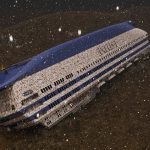Russia may have used sunken ferry Estonia to spy on NATO

Russian intelligence services could have used the site of the Estonia ferry disaster in the Baltic Sea as a platform for underwater reconnaissance against NATO.
This is stated in a joint investigation by WDR, NDR and Süddeutsche Zeitung.
Journalists, citing sources in NATO security structures, reported that technical devices could have been placed near the wreckage of the ship that allow them to control underwater drones and robots, as well as collect acoustic signatures of warships and submarines of the Alliance.
Since there is a ban on diving around the crash site, the devices could have gone unnoticed.
According to the investigation, such operations could have been carried out by the Main Directorate of Deep-Sea Research (GUGI), a secret unit of the Russian Defense Ministry that deals with underwater reconnaissance and sabotage. GUGI has special ships, mini-submarines and drones; among them is the “Yantar”, which NATO considers one of the key Russian spy vessels.
In addition, journalists have discovered that Russian companies have been buying underwater surveillance equipment in the West for years through intermediary firms, including in Cyprus. The volume of such deals is estimated at about $50 million.
The material also notes that underwater sensors that may have originated in Russia have previously been found in various countries — including Lithuania, the United Kingdom, Ireland, and Latvia.
The governments of Finland, Estonia, and Germany confirmed that they are monitoring the situation in the Baltic Sea, but declined to comment specifically for security reasons. Russia did not respond to journalists’ requests.
As a reminder, the Estonia ferry disaster occurred in the Baltic Sea in 1994, when the ship was sailing from Tallinn to Stockholm. As a result of the accident, 852 people died or went missing (only 94 bodies were found), and 138 people were rescued.





